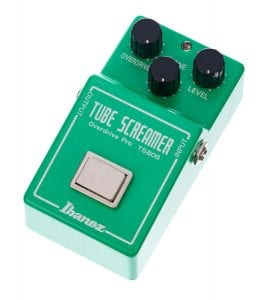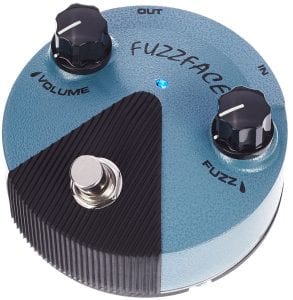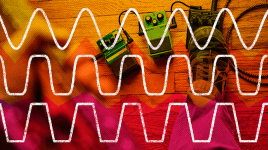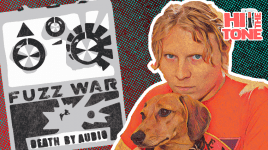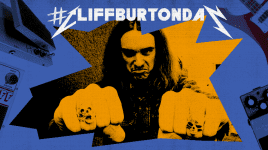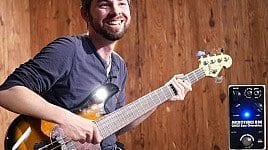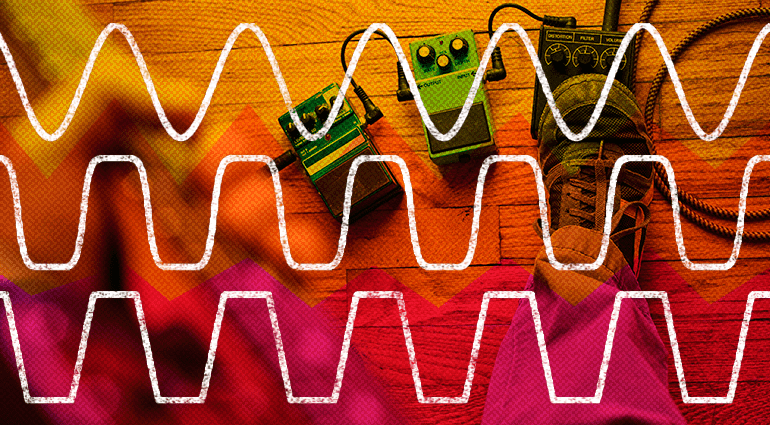
Pushing the amplifier to its limit, to make it “break up” was a common thing in the ’40s. Blues guitarists wanted that raunchy gritty sound – as did Chuck Berry in the ’50s, but there was a problem: the only way to achieve this was cranking the amplifier all the way up.
With the evolution of technology, engineers were able to re-create the gain stages inside little boxes, called pedals: this, combined with the introduction of power attenuators, allowed people to go full distortion (or fuzz, or overdrive) without deafening people with the amp’s volume. But what’s the difference between the three main types of gain (overdrive, distortion, fuzz)? Let’s find out!
Overdrive pedals
Overdrive pedals aim at recreating the sound of a tube amplifier pushed to the maximum level, resulting in a hot and thick distortion that’s perfectly suitable for blues and rock genres. This happens because the amplified signal exceeds the capacity of the tube itself and distorts the sound as a “counter-effect” which happens to be one of the most sought–after sound in music history.
- Boss SD-1 Overdrive
- Ibanez TS808
- Friedman Golden Pearl Overdrive
Overdrive is not the only way to boost an amp: in fact, booster (clean booster or treble booster) are widely used to ‘preserve’ the amp sound while pushing the sound to the natural breakup (without having to crank the master volume). Brian May and Ritchie Blackmore are fans of treble boosters paired with Vox AC30 and Marshall Bluesbreaker amplifiers.
Stevie Ray Vaughan, on the other hand, was widely known for using the legendary Ibanez Tube Screamer while Eddie Van Halen is more of a Boss SD-1 fan. You can check their respective records and songs to hear the difference in tone and sound and to better understand what separates a ‘boost’ (treble boost, clean boost) from an overdriven sound.
Distortion pedals
The distortion pedal creates a much more saturated sound, generating a less-natural clipped signal that the overdrive can’t really match. The sound obtained is popular in heavy rock, grunge, metal and more aggressive and intense music genres.
- MXR Distortion+
- Boss DS-1
- MXR Badass 78 Distortion
Despite modern tube amps being able to produce distorted sounds with ease, using a pedal can sometimes be the perfect solution for nailing certain tones. Dimebag Darrel and Randy Rhoads were fond of the MXR Distortion+ pedal, while Steve Vai, Malmsteen and Satriani prefer the Boss DS-1 sound.
Fuzz pedals
Fuzz pedals are technically distortion pedals, but the sound is quite different: fat, harmonically rich, drone-like (to certain extent, at certain settings) and reminiscent of the good ol’ psychedelic rock of the 60s. The sound generated is closer to a ‘faulty‘ amplifier, allowing the length of every note to sustain like crazy.
- Dunlop Jimi Hendrix Fuzz Face Mini
- Electro Harmonix Big Muff PI USA
- Electro Harmonix Green Russian Big Muff Fuzz
The Fuzz Face, a popular pedal used by Jimi Hendrix, is always a safe choice. That being said, every guitarist on the planet knows the word “Big Muff“, associated with the Electro Harmonix Big Muff pedal that’s so iconic that you can even buy pillows shaped like it these days. The list of artists that used the Big Muff is so long that we won’t bother to mention them all, but trust us: it sounds great!
Ok, but I still don’t understand the difference between overdrive and distortion!
In the video below, Andy and Kris explain the difference between overdrive and distortion pedals in a clear, not-too-technical way…
You are currently viewing a placeholder content from Youtube. To access the actual content, click the button below. Please note that doing so will share data with third-party providers.
Gear used in the video
What’s your favourite type of distortion sound? Do you use them combined? Let us know with a comment below
You are currently viewing a placeholder content from Facebook. To access the actual content, click the button below. Please note that doing so will share data with third-party providers.
More InformationYou are currently viewing a placeholder content from Instagram. To access the actual content, click the button below. Please note that doing so will share data with third-party providers.
More InformationYou are currently viewing a placeholder content from X. To access the actual content, click the button below. Please note that doing so will share data with third-party providers.
More Information
